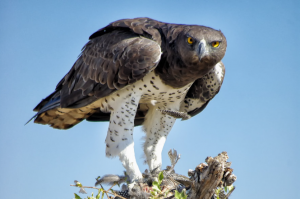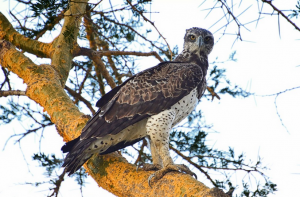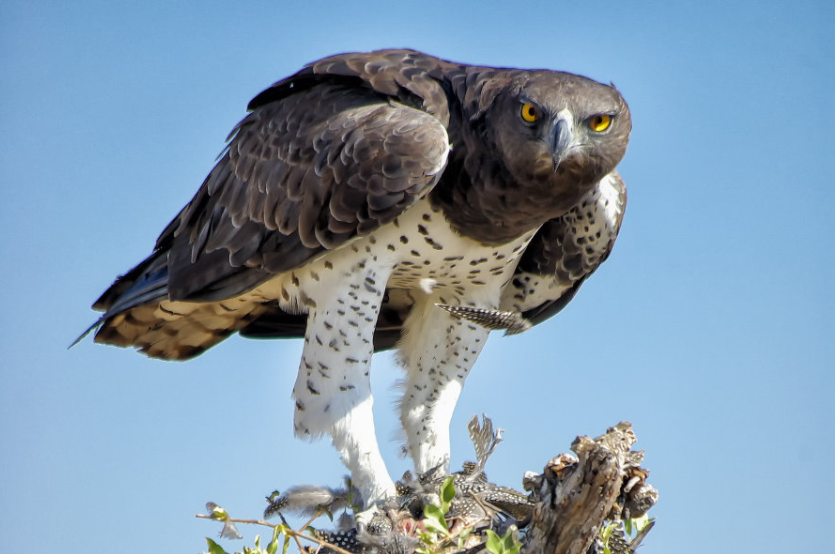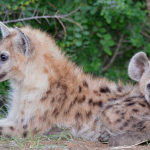The African Martial eagle
The African Martial eagle
The African Martial eagle : (polemaetus bellicosus) is a large eagle native to sub-Saharan Africa in countries like Uganda, Ghana, Zambia, Malawi and many more. It is the only member of the genus polemaetus, a species of the booted eagle sub-family (Aguilinae) and has feathering over its tarsus. One of the largest and most powerful species of booted eagle, it is a fairly opportunistic predator varying its prey selection between mammals, birds and reptiles. Its hunting technique is unique as it is one of the few eagle species known to hunt primarily from a high soar, by stooping on its quarry. Due to its habit of taking livestock and regionally valuable game, local farmers and game wardens frequently seek to eliminate martial eagles, although the effect of eagles on prey is almost certainly considerably exaggerated. The martial eagle is perhaps naturally scarce due to its requirement for large territories and low reproductive rates.
 Description
Description
Martial eagles are Africa’s largest eagles and males are slightly smaller than females nearly (76% of the size). The adults have brown upper-parts, a short and dark crest, underparts are white with brown to black spots that extend to feathered legs and the bill is long, strongly hooked and black. Toes are bluish gray and armed with large curved talons, wings are long and slightly pointed with dark under-wing coverts, however the flight feathers are barred. The tail is short, lighter in appearance and is also barred although females have more spots on the underparts than males. Juveniles have pale to white upper-parts and have pale wings with light under-wing coverts.
Behavior
Martial eagles exceptional amount of time in air and spends most of the time hunting or soaring high above the ground and only perceived via binoculars (normally invisible to the naked eyes) with the help of their large wings and broad tail, they are able to soar excellently although poor on maneuvering which directly explains why they avoid dense forests. These birds hunt by attacking in a well-controlled dive at a slanted angle and striking prey with their long legs. These eagles often perch on dead branches and trees that gives them a wide view of the areas and generally return to these perches when resting interestingly since they are very shy birds and often avoid humans. When not breeding, both mature eagles from a breeding pair may be found roosting on their own in some prominent tree up to several miles from their nesting, hunting for several days in one area, until viable prey resources are exhausted, and then moving on to another area. However, martial eagles, especially adult birds, are typically devoted to less disturbed areas, both due to these typically offering more extensive prey selection and their apparent dislike for a considerable human presence. Martial eagles tend to be very solitary and are not known to tolerate others of the own species in the area outside of the pair during the breeding season.

Reproduction
Martial eagles have a slow breeding rate and nest in large trees or pylons often situated on hill sides and the nest is enormous about (4-6 feet in diameter) made of sticks up to 1.5 inches in diameter and lined with green leaves. Pairs may build multiple nests (up to 7 nests in a given territory) and alternate between nests on successive years. The nests are often re-used from year to year with the female repairing parts of the structure and re-lining the interior with leaves. Mating seasons vary across the geographical ranges, although it generally occurs during the dry seasons and often breed once every two years. The females lay generally 1-2 eggs and incubation lasts for 45 to 50 days, and chicks fledge 90 to 100 days. However males have been observed incubating and males rarely bring food to incubating females until the eggs hatch, thereafter males will hunt and feed females for approximately 2 months. Chicks are born without feathers and become fully fledged after 90 days, and after which they attempt their flight and spend several years in the nest before being chased off by the adults. Juveniles remain close to the nest for up to 6 months, and do not reach full independence until 2 to 3 years of age and reach reproductive maturity at 4 to 5 years of age. Generally martial eagles lack a mating dance although both sexes will make a loud distinctive cry during mating periods and form monogamous pairs which they mate with for life.
Vocalization
Martial eagles are silent for most of the year, however during mating season they cry kwi-kwi-kluee-kluee. Like all birds, martial eagles perceive their environment through tactile, auditory, visual and chemical stimuli. The martial eagle is a weak and infrequent vocalizer since vocal activity has been reported even during the breeding season. The recorded contact call between pair members consists of the birds, usually when perched, letting out a low mellow whistle, ko_wee_oh. More or less the same vocalization is known to have been uttered by females when male brings food and repeated mildly by begging young ones. During territorial aerial display and sometimes when perched, adults may utter a loud, trilling klee_klee_klooeee_kulee. The territorial call may be heard from some distance. A soft quop may be heard, made by pairs around their nest, perhaps being a mutual contact call.
Feeding
Martial eagles eat a variety of medium sized mammals, birds and lizards usually weighing between 1-5 kilograms, determined anything available in their territories including much larger animals like cape hares, squirrels, mongooses to mention a few. At times game birds and waterfowl make up a large portion of their diet including francolins, bustards, guinea fowls and many more. In addition, martial eagles also prey on animals like small antelopes, Thomson’s gazelles, young impalas, vervet monkeys, baboons, snakes, monitor lizards to mention but a few and eagles have been seen killing and eating up to 35 kilograms.











Leave a Reply
Want to join the discussion?Feel free to contribute!